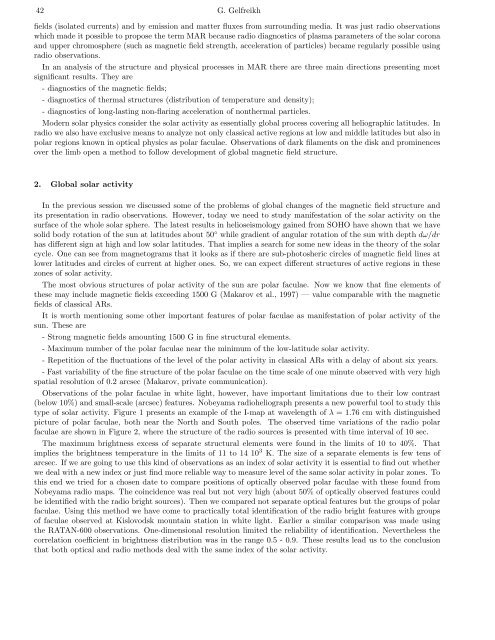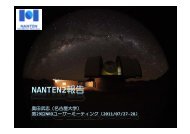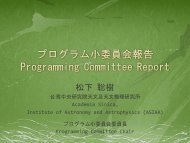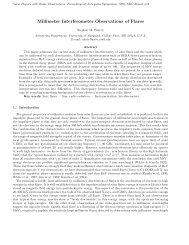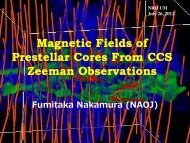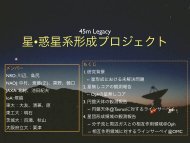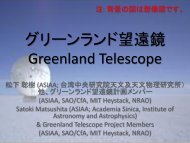Physics of the Solar Active Regions from Radio Observations
Physics of the Solar Active Regions from Radio Observations
Physics of the Solar Active Regions from Radio Observations
You also want an ePaper? Increase the reach of your titles
YUMPU automatically turns print PDFs into web optimized ePapers that Google loves.
42 G. Gelfreikhfields (isolated currents) and by emission and matter fluxes <strong>from</strong> surrounding media. It was just radio observationswhich made it possible to propose <strong>the</strong> term MARbecause radio diagnostics <strong>of</strong> plasma parameters <strong>of</strong> <strong>the</strong> solar coronaand upper chromosphere (such as magnetic field strength, acceleration <strong>of</strong> particles) became regularly possible usingradio observations.In an analysis <strong>of</strong> <strong>the</strong> structure and physical processes in MAR<strong>the</strong>re are three main directions presenting mostsignificant results. They are- diagnostics <strong>of</strong> <strong>the</strong> magnetic fields;- diagnostics <strong>of</strong> <strong>the</strong>rmal structures (distribution <strong>of</strong> temperature and density);- diagnostics <strong>of</strong> long-lasting non-flaring acceleration <strong>of</strong> non<strong>the</strong>rmal particles.Modern solar physics consider <strong>the</strong> solar activity as essentially global process covering all heliographic latitudes. Inradio we also have exclusive means to analyze not only classical active regions at low and middle latitudes but also inpolar regions known in optical physics as polar faculae. <strong>Observations</strong> <strong>of</strong> dark filaments on <strong>the</strong> disk and prominencesover <strong>the</strong> limb open a method to follow development <strong>of</strong> global magnetic field structure.2. Global solar activityIn <strong>the</strong> previous session we discussed some <strong>of</strong> <strong>the</strong> problems <strong>of</strong> global changes <strong>of</strong> <strong>the</strong> magnetic field structure andits presentation in radio observations. However, today we need to study manifestation <strong>of</strong> <strong>the</strong> solar activity on <strong>the</strong>surface <strong>of</strong> <strong>the</strong> whole solar sphere. The latest results in helioseismology gained <strong>from</strong> SOHO have shown that we havesolid body rotation <strong>of</strong> <strong>the</strong> sun at latitudes about 50 ◦ while gradient <strong>of</strong> angular rotation <strong>of</strong> <strong>the</strong> sun with depth dω/drhas different sign at high and low solar latitudes. That implies a search for some new ideas in <strong>the</strong> <strong>the</strong>ory <strong>of</strong> <strong>the</strong> solarcycle. One can see <strong>from</strong> magnetograms that it looks as if <strong>the</strong>re are sub-photosheric circles <strong>of</strong> magnetic field lines atlower latitudes and circles <strong>of</strong> current at higher ones. So, we can expect different structures <strong>of</strong> active regions in <strong>the</strong>sezones <strong>of</strong> solar activity.The most obvious structures <strong>of</strong> polar activity <strong>of</strong> <strong>the</strong> sun are polar faculae. Now we know that fine elements <strong>of</strong><strong>the</strong>se may include magnetic fields exceeding 1500 G (Makarov et al., 1997) — value comparable with <strong>the</strong> magneticfields <strong>of</strong> classical ARs.It is worth mentioning some o<strong>the</strong>r important features <strong>of</strong> polar faculae as manifestation <strong>of</strong> polar activity <strong>of</strong> <strong>the</strong>sun. These are- Strong magnetic fields amounting 1500 G in fine structural elements.- Maximum number <strong>of</strong> <strong>the</strong> polar faculae near <strong>the</strong> minimum <strong>of</strong> <strong>the</strong> low-latitude solar activity.- Repetition <strong>of</strong> <strong>the</strong> fluctuations <strong>of</strong> <strong>the</strong> level <strong>of</strong> <strong>the</strong> polar activity in classical ARs with a delay <strong>of</strong> about six years.- Fast variability <strong>of</strong> <strong>the</strong> fine structure <strong>of</strong> <strong>the</strong> polar faculae on <strong>the</strong> time scale <strong>of</strong> one minute observed with very highspatial resolution <strong>of</strong> 0.2 arcsec (Makarov, private communication).<strong>Observations</strong> <strong>of</strong> <strong>the</strong> polar faculae in white light, however, have important limitations due to <strong>the</strong>ir low contrast(below 10%) and small-scale (arcsec) features. Nobeyama radioheliograph presents a new powerful tool to study thistype <strong>of</strong> solar activity. Figure 1 presents an example <strong>of</strong> <strong>the</strong> I-map at wavelength <strong>of</strong> λ =1.76 cm with distinguishedpicture <strong>of</strong> polar faculae, both near <strong>the</strong> North and South poles. The observed time variations <strong>of</strong> <strong>the</strong> radio polarfaculae are shown in Figure 2, where <strong>the</strong> structure <strong>of</strong> <strong>the</strong> radio sources is presented with time interval <strong>of</strong> 10 sec.The maximum brightness excess <strong>of</strong> separate structural elements were found in <strong>the</strong> limits <strong>of</strong> 10 to 40%. Thatimplies <strong>the</strong> brightness temperature in <strong>the</strong> limits <strong>of</strong> 11 to 14 10 3 K. The size <strong>of</strong> a separate elements is few tens <strong>of</strong>arcsec. If we are going to use this kind <strong>of</strong> observations as an index <strong>of</strong> solar activity it is essential to find out whe<strong>the</strong>rwe deal with a new index or just find more reliable way to measure level <strong>of</strong> <strong>the</strong> same solar activity in polar zones. Tothis end we tried for a chosen date to compare positions <strong>of</strong> optically observed polar faculae with <strong>the</strong>se found <strong>from</strong>Nobeyama radio maps. The coincidence was real but not very high (about 50% <strong>of</strong> optically observed features couldbe identified with <strong>the</strong> radio bright sources). Then we compared not separate optical features but <strong>the</strong> groups <strong>of</strong> polarfaculae. Using this method we have come to practically total identification <strong>of</strong> <strong>the</strong> radio bright features with groups<strong>of</strong> faculae observed at Kislovodsk mountain station in white light. Earlier a similar comparison was made using<strong>the</strong> RATAN-600 observations. One-dimensional resolution limited <strong>the</strong> reliability <strong>of</strong> identification. Never<strong>the</strong>less <strong>the</strong>correlation coefficient in brightness distribution was in <strong>the</strong> range 0.5 - 0.9. These results lead us to <strong>the</strong> conclusionthat both optical and radio methods deal with <strong>the</strong> same index <strong>of</strong> <strong>the</strong> solar activity.


